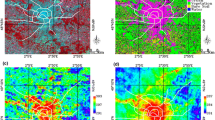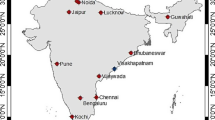Abstract
Temperature is one of the factors which affects the meteorological phenomenon prevailing in an urban area and ultimately leads to climate change and global warming. Measurement of surface temperature with conventional temperature sensors is tedious, has single point value and expensive. Satellite data of 2005, 2008, 2010 and 2016 are used to assess the land use land cover (LULC) and to measure the land surface temperature (LST) during the hottest month of May in Nagpur city, India. Based on the image analysis, it is observed that there is an increase in the average temperature from 40.0 to 44.6 ºC. This may be due to an increase in built-up area from 55.5 to 69.8% during 2005 to 2016, respectively. It has also been revealed that the outskirts of the city are hotter than the central portion of the city as there is more barren land on the outskirts. Results were compared to ambient temperature sensor that showed good agreement between temperature retrieved from satellite and temperature sensor. The study suggests that urban areas should be developed intermixed with vegetation and plantation and provisions of green belt along the city roads, highways and ring roads. Based on LST and LULC analysis, a green belt of 30 m along both sides of the road would lower the road temperature by 9.3 ºC from existing temperature of 44.7 ºC. This would help in lowering down the average temperature of the city.










Similar content being viewed by others
References
Aguilar-Lome J, Espinoza-Villar R, Espinoza JC, Rojas-Acuña J, Willems BL, Leyva-Molina WM (2019) Elevation-dependent warming of land surface temperatures in the Andes assessed using MODIS LST time series (2000–2017). Int J Appl Earth Obs Geoinform 77:119–128
Amiri R, Weng Q, Alimohammadi A, Alavipanah SK (2009) Spatial–temporal dynamics of land surface temperature in relation to fractional vegetation cover and land use/cover in the Tabriz urban area. Iran Remote Sens Environ 113:2606–2617
Arrau CP Pena MA. (2010) The Urban Heat Island (UHI) Effect. https://www.urbanheatislands.com
Artis DA, Carnahan WH (1982) Survey of emissivity variability in thermography of Urban areas. Remote Sens Environ 12:313–329
Avdan U, Jovanovska G (2016) Algorithm for automated mapping of land surface temperature using landsat 8 satellite data. J Sens. https://doi.org/10.1155/2016/1480307
Baede APM, Ahlonsou E, Ding Y., Schimel D. (2001) The Climate system: an overview. In: Houghton JT. Climate Change 2001: The scientific basis. Contribution of WGI to the 3rd Assessment Report, IPCC, Cambridge Univ. Press, Cambridge
Blaschke T (2010) Object based image analysis for remote sensing. ISPRS J Photogrammetry Remote Sens 65:2–16
Carlson TN, J. Augustine JA Boland FE. (1977) Potential application of satellite temperature measurements in the analysis of land use over urban areas. Bull Am Meteor Soc 58:1301–1303
Chakraborty SD, Kant Y, Bharath BD (2014) Study of land surface temperature in delhi city to managing the thermal effect on urban developments. Int J Adv Sci Tech Res 4(1):439–450
Chander G, Markham BL, Helder DL (2009) Summary of current radiometric calibration coefficients for Landsat MSS, TM, ETM+, and EO-1 ALI sensors. Remote Sens Environ 113:893–903
Chen X, Su Z, Ma Y, Cleverly J, Liddell M (2017) An accurate estimate of monthly mean land surface temperatures from MODIS clear-sky retrievals. J hydrometeorol. 18(10):2827–2847
Cheng J, Liang S. 5.10—Land-surface emissivity. Comprehensive Remote Sensing; Liang, S., Ed.; Elsevier: Oxford, UK. 2018:217–63.
Chudnovsky A, Ben-Dor E, Saaroni H (2004) Diurnal thermal behavior of selected urban objects using remote sensing measurements. Energ Build 36:1063–1074
CIMIS (2009) ET Overview. (California Irrigation Management Information System) https://www.cimis.water.ca.gov/cimis/infoEtoOverviewPF.jsp
Dash P, Göttsche FM, Olesen FS, Fischer H (2002) Land surface temperature and emissivity estimation from passive sensor data: theory and practice-current trends. Int J Remote Sens 23(13):2563–2594
Dyras I, Dobesch H, Grueter E, Perdigao A, Tveito OE, Thornes JE, van der Wel F, Bottai L (2005) The use of geographic information systems in climatology and meteorology. Meteorol Appl 12(1):1–5
EPA (2009a) Reducing Urban Heat Islands: Compendium of Strategies—Urban Heat Island Basics. https://www.epa.gov/heatisland/resources/pdf/BasicsCompendium.pdf. Accessed 15 Feb 2017
EPA (2009b) Heat Island Effect. https://www.epa.gov/heatisland/about/index.html. Accessed 15 Feb 2017
Fortuniak K (2009) Global environmental change and urban climate in Central European cities. International Conference on Climate Change. The environmental and socio-economic response in the southern Baltic region, Szczecin, Poland.
Friend MA (2002) Forward and inverse modeling of land surface energy balance using surface temperature measurements. Remote Sens Environ 79:344–354
Geer IW (1996) Glossary of Weather and Climate, with Related Oceanic and Hydrolic Terms. American Meteorological Society.
Ghosh S, Mondal A, Bhallamudi SM, Narsimhan B, Majumdar PP (2015) Chennai floods: a rapid assessment, interdisciplinary center for water research. Interdisciplinary center for water research, Bangalore
Gill SE, Handley JF, Ennos AR, Pauleit S (2007) Adapting cities for climate change: the role of the green infrastructure. Built Environ 33:115–113
Gillespie AR, Rokugawa S, Matsunaga T, Cothern JS, Hook SJ, Kahle AB (1998) A temperature and emissivity separation algorithm for advanced spaceborne thermal emission and reflection radiometer (ASTER) images. IEEE Trans Geosci Remote Sens 36:1113–1126
Guha S, Govil H, Dey A, Gill N (2018) Analytical study of land surface temperature with NDVI and NDBI using Landsat 8 OLI and TIRS data in Florence and Naples city Italy. Euro J Remote Sens 51(1):667–678
Hay GJ, Castilla G. (2006) object-based image analysis: strengths, weaknesses, opportunities and threats (SWOT). The International Archives of the Photogrammetry, Remote Sensing and Spatial Information Sciences
Jin M, Shepherd JM, Peters-Lidard C (2007) Development of a parameterization for simulating the urban temperature hazard using satellite observations in climate model. Nat Hazards 43(2):257–271
Katpatal YB, Kute A, Satapathy DR (2008) Surface-and air-temperature studies in relation to land use/land cover of Nagpur urban area using Landsat 5 TM data. J Urban Plan Develop 134(3):110–118
Kim HY, Liang S (2010) Development of a hybrid method for estimating land surface shortwave net radiation from MODIS data. Remote Sens Environ 114(11):2393–2402
Khandelwal S, Goyal R, Kaul N, Mathew A (2018) Assessment of land surface temperature variation due to change in elevation of area surrounding Jaipur, India. Egypt J Remote Sens Space Sci. 21(1):87–94
Kharol SK, Kaskaoutis DG, Sharma AR, Singh RP (2013) Long term (1951–2007) Rainfall trends around six Indian cities: current state, meteorological, and Urban dynamics. Adv Meteorol. https://doi.org/10.1155/2013/572954
Klysik K, Fortuniak K (1999) (1999) Temporal and spatial characteristics of the urban heat island of Lodz. Poland Atmos Environ 33:3885–3895
Lo CP, Quattrochi DA, Luvall JC (1997) Application of high-resolution thermal infrared remote sensing and GIS to assess the urban heat island effect. Int J Remote Sens 18:287–304
Malik MS, Shukla JP (2018) Retrieving of land surface temperature using thermal remote sensing and GIS techniques in Kandaihimmat Watershed, Hoshangabad, Madhya Pradesh. J Geol Soc India 92(3):298–304
Mallick J, Kant Y, Bharath BD (2008) Estimation of land surface temperature over Delhi using Landsat-7 ETM+. J Ind Geophys 12(3):131–140
Mallick J, Singh CK, Shashtri S, Rahman A, Mukherjee S (2012) Land surface emissivity retrieval based on moistureindex from LANDSAT TM satellite data over heterogeneous surfaces of Delhi city. Int J Appl Earth Obs Geoinf 19:348–358
Mitraka Z, Chrysoulakis N (2018) Earth observation for Urban climate monitoring: surface cover and land surface temperature. Multi-Purposeful Appl Geospatial Data 9:125
Nagpur Metropolitan Area Development Plan (NMRDA) 2012–2032, Draft Development Plan Report, Published u/s 26 of the Maharashtra Regional and Town Planning Act, 1966, Feburary 2015, Nagpur Improvement Trust
NASA (2004) Landsat Project Science Office: Landsat 7 Science data users hand book, Chapter: 11, Data Products. https://www.gsfc.nasa.gov/IAS/handbook/handbook_htmls. Accessed 20 Feb 2017
Owen TW, Carlson TN, Gillies RR (1998) Remotely sensed surface parameters governing urban climate change. Int J Remote Sens 19:1663–1681
Parida BR, Oinam B, Patel NR, Sharma N, Kandwal R, Hazarika MK (2008) Land surface temperature variation in relation to vegetation type using MODIS satellite data in Gujarat state of India. Int J Remote Sens 29(14):4219–4235
Parry ML, Canziani OF, Palutikof JP, van der Linden PJ, Hanson CE (2007) Contribution of Working Group II to the Fourth Assessment Report of the Intergovernmental Panel on Climate Change. (Cambridge University Press). https://www.ipcc.ch/publications_and_data/ar4/wg2/en/ch19s19-3-6.html. Accessed 15 Feb 2017
Ramachandra TV, Kumar U (2010) Greater Bangalore: Emerging Urban Heat Island. https://www.gisdevelopment.net/application/urban/sprawl/Greater-Bangalore-EmergingUrban-Heat-Island.htm. Accessed 2 Mar 2017
Rose LA, Devadas MD. (2009) Analysis of and surface temperature and land use/ land cover types using remote sensing imagery—a case in Chennai city, India. In: Seventh International Conference on Urban Climate, Yokohama, Japan.
Santana LM (2007) Landsat ETM+ image applications to extract information for environmental planning in a Colombian city. Int J Remote Sens 28:4225–4242
Schott JR, Volchok WJ (1985) Thematic mapper thermal infrared calibration. Photogrammetric Eng Remote Sens 51:1351–1357
Senay GB, Budde M, Verdin JP, Melesse AM (2007) A coupled remote sensing and simplified surface energy balance approach to estimate actual evapotranspiration from irrigated fields. Sensors 7(6):979–1000
Snyder WC, Wan Z, Zhang Y, Feng YZ (1998) Classification-based emissivity for land surface temperature measurement from space. Int J Remote Sens 19:2753–2774
Tomlinson CJ, Chapman L, Thornes JE, Baker C (2011) Remote sensing land surface temperature for meteorology and climatology: a review. Meteorol Appl 18(3):296–306
Tran H, Uchihama D, Ochi S, Yasuoka Y (2006) Assessment with satellite data of the urban heat island effects in Asian mega cities. Int J Appl Earth Obs Geoinf 8:34–48
United Nations (2007) World Urbanization Prospects: The 2007 Revision Population Database.
Vicente-Serrano SM, Lasanta P-C-FT (2008) Assessment of radiometric correction techniques in analyzing vegetation variability and change using time series of Landsat images. Remote Sens Environ 112:3916–3934
Vijay R, Sharma A, Chakrabarti T, Gupta R (2015) Assessment of honking impact on traffic noise in urban traffic environment of Nagpur, India. J Environ Health Sci Eng 13(1):10
Voogt JA (2002) Urban heat Island. In : Munn T (ed) Encyclopedia of global environmental change. 3:660-666 (Chichester: Wiley)
Watson K (1992) Spectral ratio method for measuring emissivity. Remote Sens Environ 42:113–116
Weng QA (2001) Remote sensing–GIS evaluation of urban expansion and its impact on surface temperature in the Zhujiang Delta China. Int J Remote Sens 22:1999–2014
Weng Q, Lu D, Schubring J (2004) Estimation of land surface temperature-vegetation abundance relationship for urban heat island studies. Remote Sens Environ 89:467–483
Weng Q, Yang S (2004) Managing the adverse thermal effects of urban development in a densely populated Chinese city. J Environ Manage 70:145–156
Weng Q (2009) Thermal infrared remote sensing for urban climate and environmental studies: methods, applications, and trends. ISPRS J Photogrammetry Remote Sens 64(4):335–344
WWF (2010) Natural Resources (World Wildlife Fund).https://wwf.panda.org/about_our_earth/teacher_resources/webfieldtrips/natural_resources/. Accessed 10 Mar 2017
Yuan F, Bauer ME (2007) Comparison of impervious surface area and normalized difference vegetation index as indicators of surface urban heat island effects in Landsatimagery. Remote Sens Environ 106:375–386
Zhang J, Wang Y, Wang Z (2007) Change analysis of land surface temperature based on robust statistics in the Estuarine area of Pearl River (China) from 1990 to 2000 by Landsat TM/ETM+ Data. Int J Remote Sens 28:2383–2390
Zhang J, Wang Y (2008) Study of the relationships between the spatial extent of surface Urban Heat Islands and Urban characteristic factors based on lands at ETM+ Data. Sensors 8:7453–7468. https://doi.org/10.3390/s8117453
Zullo F, Fazio G, Romano B, Marucci A, Fiorini L (2019) Effects of urban growth spatial pattern (UGSP) on the land surface temperature (LST): a study in the Po Valley (Italy). Sci Total Environ 650:1740–1751
Author information
Authors and Affiliations
Corresponding author
Additional information
Publisher's Note
Springer Nature remains neutral with regard to jurisdictional claims in published maps and institutional affiliations.
Rights and permissions
About this article
Cite this article
Sakhre, S., Dey, J., Vijay, R. et al. Geospatial assessment of land surface temperature in Nagpur, India: an impact of urbanization. Environ Earth Sci 79, 226 (2020). https://doi.org/10.1007/s12665-020-08952-1
Received:
Accepted:
Published:
DOI: https://doi.org/10.1007/s12665-020-08952-1




